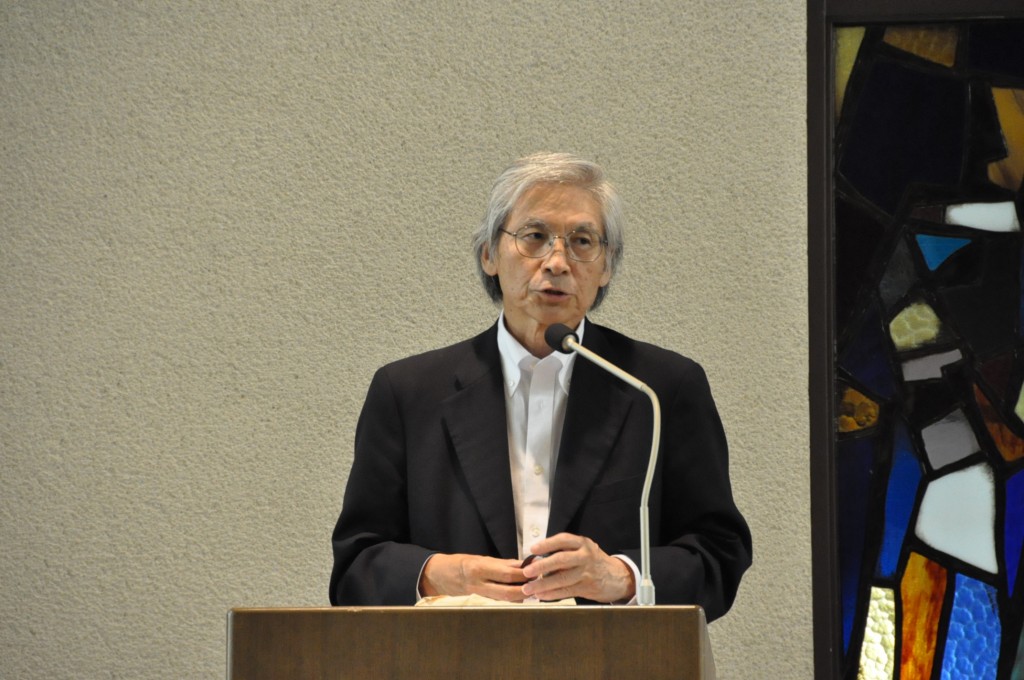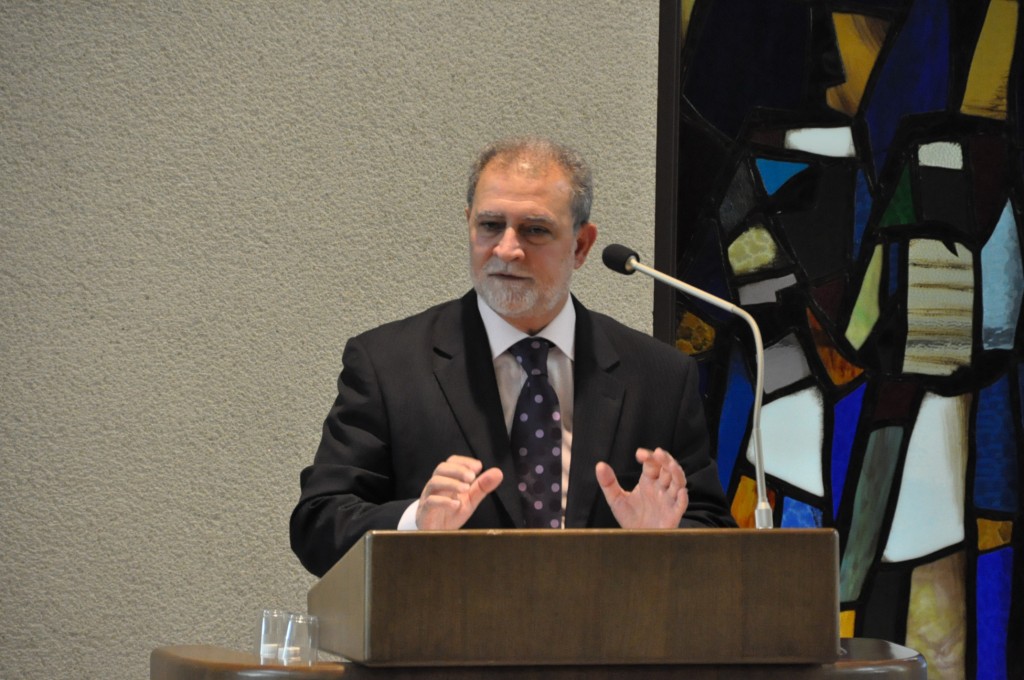Center for Interdisciplinary Study of Monotheistic Religions(CISMOR)Doshisha University
> Public Lectures > Arab’s Spring and the US-Middle East RelationsPublic Lectures
Open Lecture by Project 2
Arab’s Spring and the US-Middle East Relations
| Date: |
2011/07/23 13:30 − 16:00 |
|---|---|
| Place: | Divinity Hall Chapel, Imadegawa Campus, Doshisha University |
| Lecture: |
Toshinori SHIGEIE, Former Director of a Middle Eastern and African Affairs Bureau, Ministry of Foreign Affairs, Guest professor of Doshisha University Azzam TAMIMI, Director of Institute of Islamic Political Thought in London |
| Summary: | |
|
A lecture meeting titled, “The Arab Spring and U.S.-Middle East Relations,” was organized by CISMOR jointly with the “Interdisciplinary Study of Conflict Mitigation in the Middle East,” a project led by Dr. Hisae Nakanishi, and was funded by Grants-in-Aid for Scientific Research. In the meeting, lectures were delivered by Mr. Toshinori Shigeie, a guest professor of the Faculty of Law, Doshisha University, who formerly served as the Japanese ambassador to Korea and as the director of the Middle Eastern and African Affairs Bureau, Ministry of Foreign Affairs, and Dr. Azzam Tamimi, the director of the Institute of Islamic Political Thought in London. First, Ambassador Shigeie commented on the Middle East policy of the Obama administration and presented his view on its adequacy as of the time of the lecture, referring to the speech made by President Obama at Cairo University in June 2009. According to him, the Middle East policy of the Obama administration has four main priorities. The first is the withdrawal of American military forces from Afghanistan, which is of the greatest importance regarding this policy. With the presidential election looming next year, the Obama administration has a very strong will to successfully withdraw military forces in a manner that does not allow Afghanistan to further become a breeding ground for terrorists. In this sense, the death of Osama Bin Laden is “good news,” as it indicates significant progress in the U.S. fight against terror. At the same time, however, the success of the mission to kill Osama Bin Laden is also “bad news,” as this makes it harder for the U.S. government to obtain the public understanding of and build consensus among American citizens on the increasing need for support to Afghanistan after the withdrawal of the military forces. The second is peace in the Middle East (the settlement of the Israel-Palestine Conflict). When Ambassador Shigeie was engaged in peace negotiations from 1993 to 1995, signing a peace agreement seemed to be nearing reality. However, the assasination of Prime Minister Rabin and the emergence of Netanyahu as the prime minister changed the situation completely. While the Obama administration currently takes no tangible action in this regard, greater difficulty will arise in the negotiation process if Palestine applies for membership in the United Nations during the General Assembly in September. Seen from the other side, however, this may open up a new opportunity to resume the peace negotiations. The third is a response to the “Arab Spring,” which could be a double-edged sword for the U.S., as it may cause drastic changes in the balance of power in the Middle East. However, the Obama administration has no choice but to support the democratization processes in this region. The U.S. should carefully tread the narrow path sandwiched between two causes—stability and democratization—taking small steps. Especially, the U.S. will face difficulties in dealing with the Syria issue in light of the sheer size of the impact on Israel. The fourth is the Iranian nuclear issue. Structurally, this issue has the largest influence on the Middle East but has been in a deadlock for some time. In the U.S., two views are prevalent on this issue at present. One is a cautiously optimistic view that proposes accepting Iran’s nuclear program and then discussing how to deal with this issue. The other view takes this issue much more seriously and expresses deep concern over the possibility of further developments of the Iranian nuclear program producing nuclear domino effects across the Middle East. However, the Obama administration has come up with no other ideas aside from imposing cautious economic sanctions on Iran, in cooperation with the international community. Based on the above analysis, Professor Shigeie discussed the fundamental characteristics of the Middle East policy (and the general diplomatic policy) of the Obama administration, putting the greatest emphasis on its responsive nature and its lack of ideological ground. This is largely attributable to the view of the world held by President Obama—his view of the world is simply “flat,” for better or for worse. Indeed, President Obama, with a very strong will, is pushing the policy of the withdrawal of military forces from Afghanistan, urged, in part, by public sentiment in the U.S. However, considering the hopes raised by his speech in Cairo, what the Obama administration has achieved so far may be said to be largely disappointing. In concluding the lecture, Professor Shigeie remarked that the Middle East policy of the Obama administration would enter a critical stage this autumn, where it would either end in “failure” or undergo drastic changes for the better. Following the lecture of Professor Shigeie, Dr. Azzam Tamimi discussed how the series of political changes in the Middle East starting with Tunisia is associated with peace in the Middle East, under the title “Arab Revolutions and the Palestinian Problem,” as follows. Seen from the standpoint of Arabic countries, the Palestinian problem is a humanitarian tragedy caused by the colonization of the Middle East by the Western countries. This problem has its roots in the Sykes-Picot Agreement signed by France and the United Kingdom in May 1916. Under this agreement, France and the United Kingdom drew lines on the map of the Middle East to divide the region into areas of British and French colonial control, and these lines remain today as the borders of Syria, Lebanon, Jordan, Iraq, and other Arabic countries. This means that the current borders of the Middle East countries were artificially defined against the will of people of this region. When the State of Israel was established with the support of the American and British governments in 1948, Palestinians were expelled from their homeland of Palestine and forced to live in refugee camps within Palestine or to immigrate to other Arabic countries and various parts of the world as refugees. Palestinians recognize the series of “Arab Revolutions” starting from January 12, 2011 and their consequences as the beginning of the end of Zionism, and thus, they welcome these movements. The Mubarak administration treated Palestinians as “unwanted nuisances,” along with the Lebanese. Because of this fact, coupled with the signing of the Egypt-Israel Peace Treaty in 1979, Palestinians thought of the Mubarak administration, as well as Tunisia, as siding with the Zionists. For this reason, the fall of the Mubarak administration encouraged Palestinians. On the other hand, both Palestinians and Khaled Mashaal, the leader of Hamas in Damascus, were unable to predict that the Egyptian revolution would trigger an uprising in Syria against Asad’s regime, which has been supporting Palestine, along with Iran. The intensifying internal conflict in Syria has now developed into a civil war and is dealing a blow to Palestinians. On the other hand, this unpredictable development has resulted in reconciliation between Fatah and Hamas. These rival Palestinian factions signed a reconciliation agreement in early May 2011 in Cairo, mediated by Egypt and Turkey, which can be viewed as an important positive change brought about by the Arab revolutions. It is also worth noting that this reconciliation increases the likelihood for the Palestine National Authority to seek a resolution of the United Nations that recognizes the establishment of an “independent state of Palestine.” In the Middle East, Arab countries that share the same language and religion will deepen solidarity at an accelerated pace, which will further facilitate the development of an Islamic movement in the Muslim world in the Middle East. After the lectures, a panel discussion was held, joined by the two lecturers and by Professor Murata and Professor Nakanishi, who served as moderators. Then, a question-and-answer session followed, in which many questions were received by the lecturers from the floor, and a heated discussion took place. With that, the lecture meeting ended in great success. Tadashi Nakatani (Research Fellow, CISMOR, Doshisha University) |
|
|
*This lecture will be given partly in English . *Admission Free, No Reservation Necessary. Hosted by: CISMOR/ Grants-in-Aid for Scientific Research (Research Representative: Hisae Nakanishi) Co-hosted by: School of Theology, Doshisha University |
|
|
Program (Japanese) |
|

